
Keke Kaikhosroshvili
Keke is Zavvy's expert in learning experience. On our blog, she shares experience and insights based on her studies in learning design and experiences made with our customers.


Your people are your biggest asset.
And how you support their professional development will largely define your whole company's success.
The idea here is not to force employees to fulfill yet another list of seasonal tasks - but to help them unleash their potential. To enable them to perform at their best. Now and in the future.
Employee development plans are also a powerful tool to boost culture, motivation, and a sense of belonging.
While you help them become more efficient, you will reap the benefits through reduced turnover and higher employee retention rates.
However, employee development is a gigantic field by itself - and even experienced People Ops managers struggle with wrapping their heads around a streamlined strategy.
Well, we can confidently say that development plans are the single most central step towards creating a fully-fleshed growth framework for your people.
And we'll show you how to get started.
Together with our curators, we have created a library of actionable digital marketing resources. Personalized to your team's needs.
An employee development plan is a structured and targeted action plan for your employee's professional growth.
In essence, it defines key competencies for individual growth - along with essential measures to get there.
The end goal: To perform better in one's existing position or acquire new skills to perform in a similar or different role.
Keep in mind that there is no universal development plan, not even one designed for a specific department.
Instead, a professional development plan has to be tailored to every individual based on their role, core competencies, and goals.
The mere notion that someone is willing to elevate themselves can make a profound difference increase their confidence, satisfaction, trust, and long-term loyalty.
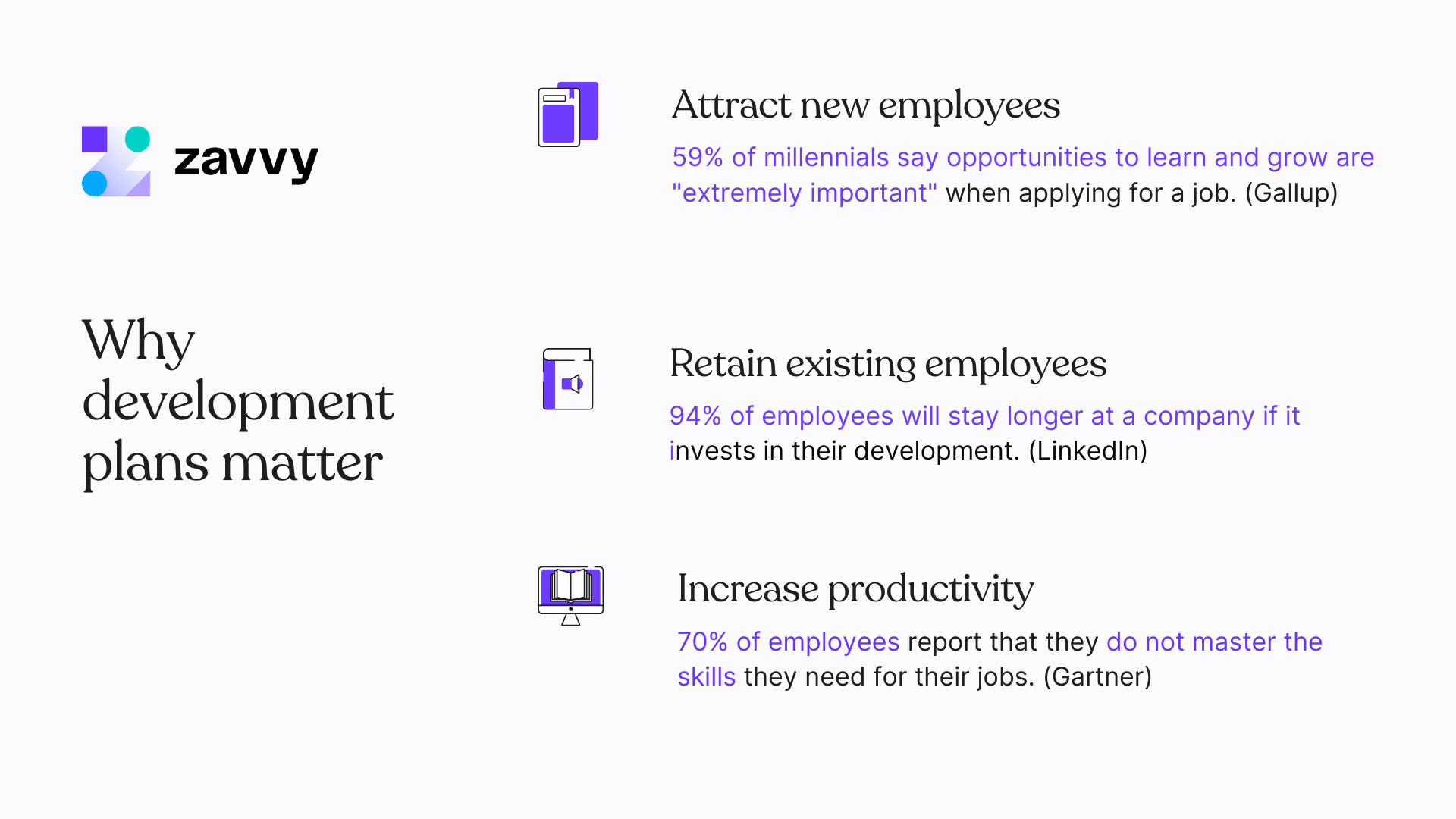
Here are some more benefits of an efficient employee development plan:
Potential employees are more likely to apply to organizations that invest in their development.
In fact, 59% of millennials say opportunities to learn and grow are "extremely important" when applying for a job.
the development programs will make your employees feel more valued, thus motivating them to continue working at your organization:
A whopping 94% of employees will stay longer at a company if it invests in their development.
Data-driven employee development is the perfect baseline for smart career progression models.
You'll be able to identify who's a fit for a promotion and help them along the way. You'll also give your people a perspective and develop them in a specific direction with precision.
Your employees will be more engaged in their role, knowing you're willing to invest in their future.
Perhaps the most critical factor for some companies - employees with improved skills will be more productive, find new solutions, and increase company revenue.
This one's pretty straightforward, right?
But there's more: 70% of employees say they don't master the skills required to do their jobs, in the first place. In that light, a development plan is rather about catching up than advancing.
Employee development plans guide you to look at your company's future so you're better equipped for new staffing-related challenges.
With these factors in mind, let's go through some practical steps to create and maintain your company's development plans.
Creating a decent professional development plan is not at all complex. All it takes is going through a series of structured steps. While every plan will differ based on your industry, company, role, and specific employee, here are some universal steps you can begin with.
This is a crucial step for your company's future and the foundation for everything that comes next.
It means looking into your company's plans for the upcoming months and years and seeing what needs to be done and how.
This is your chance - and responsibility - to give HR a strategic say at the table.
Give yourself some time for this step and ask questions like:
Once you have an honest answer to all of these questions, you'll have a great starting point, not just for one employee's career development plan but for an entire department in your organization.
Do listen to your gut feeling and include:
To complement these results, skills matrices can give you powerful insights into the competencies currently present in the org.
Start with talking to your employees or orchestrating training needs analysis to determine what kind of skill gap you have at your hand.
You can also get in touch with their people's immediate managers to discover areas of improvement.
For example, if you aim to close 30% more deals by this time next year, you should invest in upskilling your sales team as part of your employee development plans.
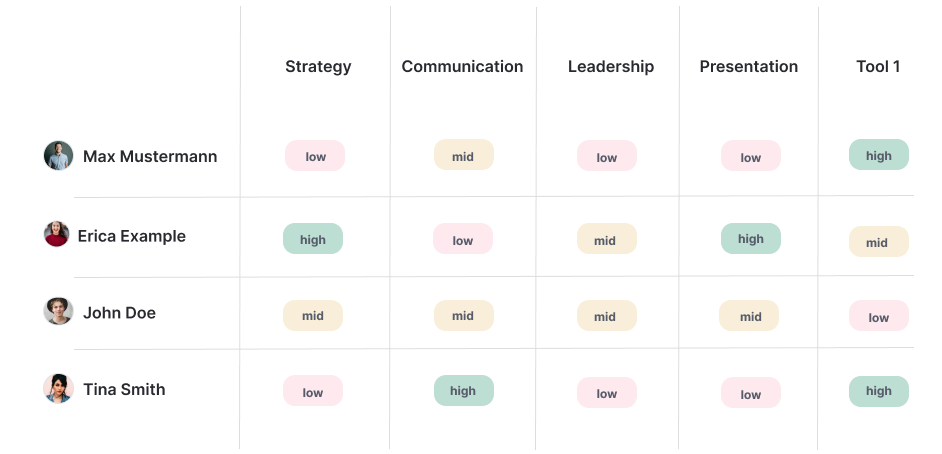
We recommend putting your people into the driver's seat of their development.
If they're not on board with the program, they will not stick with the proposed activities, and you'll be wasting both time and money.
Make them understand the overall organizational goals - but have their own aspirations determine at least 50% of the development program's focus.
To do so, we recommend creating 2-4 focus areas:
Competencies or skills that an employee wants to improve during the development cycle.
Have them create a draft by themselves - and discuss it together. Depending on the workings of your company, this is either the role of HR/L&D or the learner's people manager. Ideally, even both.
To help your colleagues find valuable focus areas, ask them a series of questions regarding their personal needs and goals within the company.
These can include:
This first conversation will be the cornerstone of your employee development plan and help you guide everyone's efforts in the right direction.
This way, you will be enriching your employees’ journey at your company during moments that matter. Developing their skill sets gives them a chance of promotion or making a lateral move in your organization. As an employer, you will get the satisfaction of your employees, crushing your organizational goals while boosting your profits.
In your communication with the employee, you should be open, welcome their feedback, and signal that development is a priority - even during busy seasons. (And we all know: things are always busy)
But, at the same time, you should stress that the program's success largely depends on their commitment and dedication.
To make your life easier, we went ahead and creates templates for you:

Download: 🧾 Employee development plan template [Spreadsheet]

Download: 📄 Employee Development Plan Template [PDF]

➡️ And if you're looking for a more streamlined experience, you can run the whole process via our employee development software:
Ambitious goals are great.
But if they're too ambitious, they will end up causing frustration.
Plus, a goal only makes sense as long as it's trackable.
If you set goals that are unmeasurable and unrealistic, you will have a hard time tracking whether the development program is working or not. For example, “improving my communication skills is a great goal to aspire to, but it’s hardly measurable. For soft skills, you’ll need to develop a different method to assess and measure them, so take your time here to create something meaningful.
The key here is having clear, well-defined goals.
We recommend following the SMART principles as drafted below:
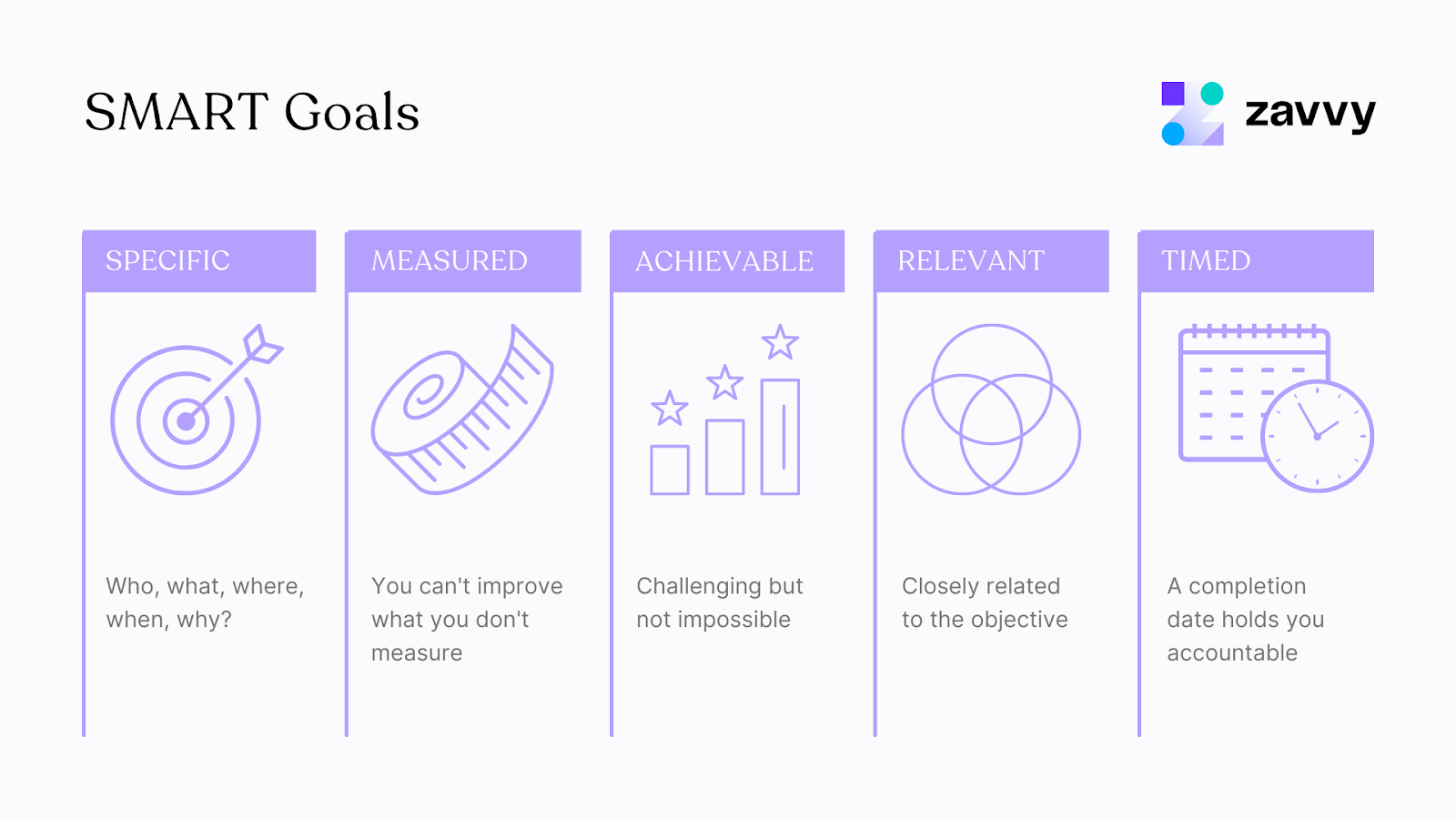
Great news - now that you know who's on board and what skills they need to fulfill their plans, people can define various activities for each focus area.
Everybody is different. And people prefer different means of learning. Plus, asking HR to define these activities is highly inefficient as they can't possibly know every role's training opportunities in detail.
Hence:
Here are some examples a decent development plan can benefit from:
Once you start doing some basic research, you'll see how many opportunities there are to upskill your employees, provided you've set a strong foundation for your employee development program.
One tip that can greatly help is to have a set of activities planned in advance.
For example, finding the right mentor for your employee will help them become better at closing sales calls.
You can offer your employees options during the very first meeting, and they can decide who they're more comfortable working with.
This way, you can hit the ground running and get started with your employee development plan immediately.
If you're open to inspiration, we've gathered 6 innovative employee development activities you can start with.
Pro tip: Encourage people to follow the 70:20:10 principle or similar splits to avoid limiting plans to mere theory.
The thing about any plan is: It's only worth as much as the action that follows.
For instance, not even 10% of the video courses get finished.
It's absolutely vital to offer support and motivate your employees during the process. Send them reminders, ask them questions, or help them create a structure to create a balance between their workflow and the training process.
The same goes for people managers: Give them guidance and a structure to use in their development talks. Remind them. Keep them going.
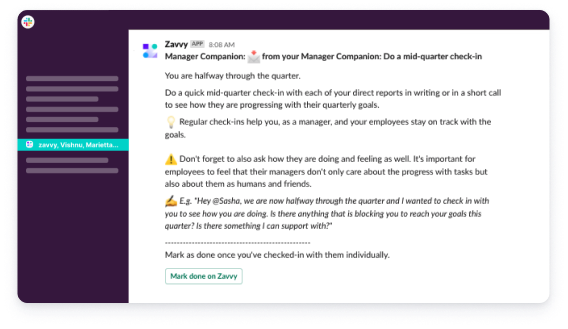
In addition, this comes down to the bigger picture. Does your company have a culture of learning? A growth mindset is the ultimate driver of continuous learning - and consequently development plan completions.
Now that you've put everything into place, it's time to track the success of your career development plan. To do that, you need to approach it from two different angles - the employee's level and the company's level.
From the employee's side, you'll want to ensure that the activities in the employee development plan are elevating their skills and making a tangible improvement over time.
Many times, it's not possible to objectively measure the progress of some skills (example: soft skills). For this, you will have to resort to interviews with your employees. Also, it's a good idea to ask their direct managers if they see any improvements moving in the right direction.
On the company's side, it gets a little bit more complex. To measure the results of your plan, in the long run, you need to keep up with how your employees are progressing at an individual level.
That can be quite a challenge, so we are here to help you simplify it by keeping track of your employee development activities.
You can use our customizable templates to schedule meetings to run pulse surveys to get more timely results. That way, you can make changes more quickly if things don't seem to be going in the right direction.
🔄 At Zavvy, we help companies implement continuous feedback from different perspectives to close the circle.
Don't be afraid to revisit your employee development plan. Doing this will help you:
Keep orchestrating assessments and re-tuning them. This will ensure your plans are effective and just what your employees need.
The only thing constant is change. And the best way to create or improvise your employee development plan is by taking inspiration from companies that have nailed them.
➡️ If you want to dive deeper, we've gathered and critiqued 6 different development plan examples to help you refine yours.
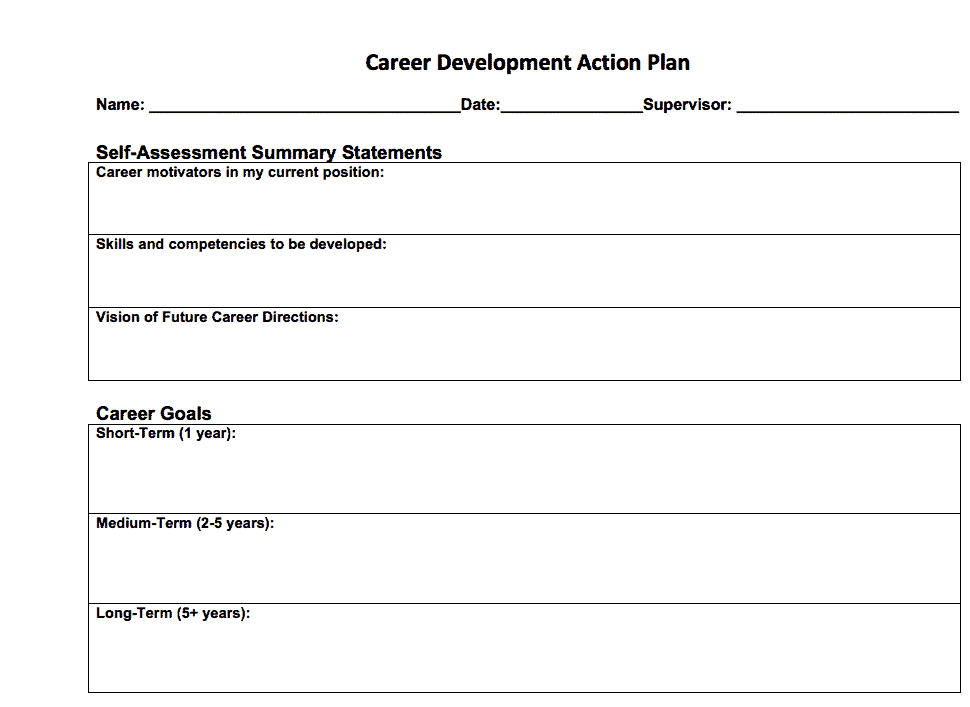
They put the weight of the employee development plan mainly on the employee. First, the employee has to do a self-assessment of their most essential motivators, skills, and competencies and how they see their future roll out in the company.
Moreover, they need to set short-, medium- and long-term goals. This is a good starting point, but the form won’t be enough to produce good results. You also need to add another layer of information through an interview with the employee.
Here is another example of a fairly simple employee development plan from SEOptimer:
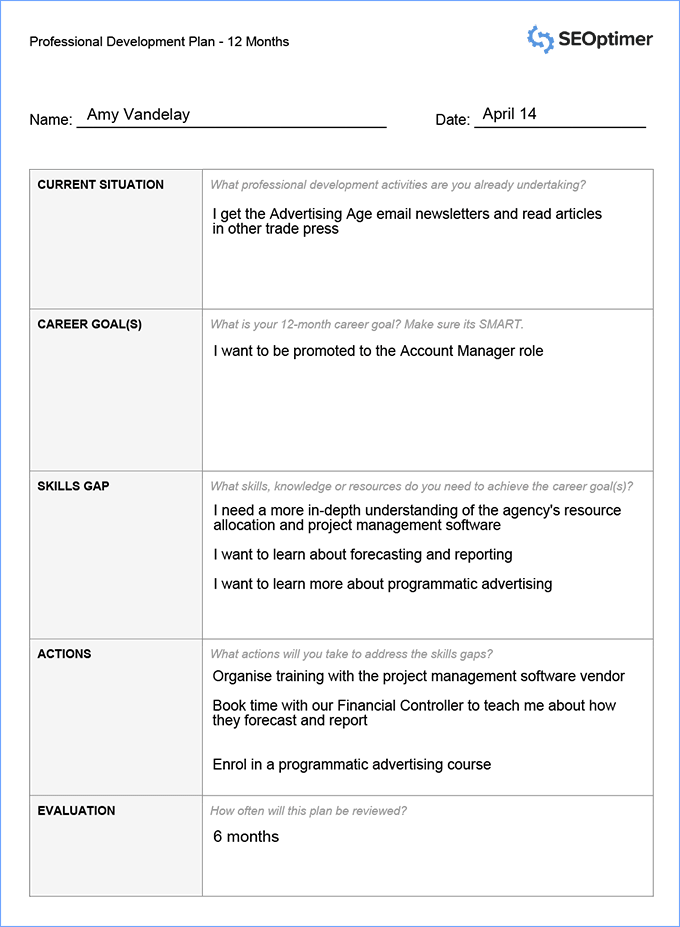
As you can see, this one allows more room for employees and employers to express their perspectives.
The only downfall: It’s quite unlikely that an employee will instinctively know what skills gap you have in the company and what specific activities they can do to get to their desired skill set.
They won’t know the ideal evaluation period either.
Here is another version of a similar employee development plan from SEOptimer:
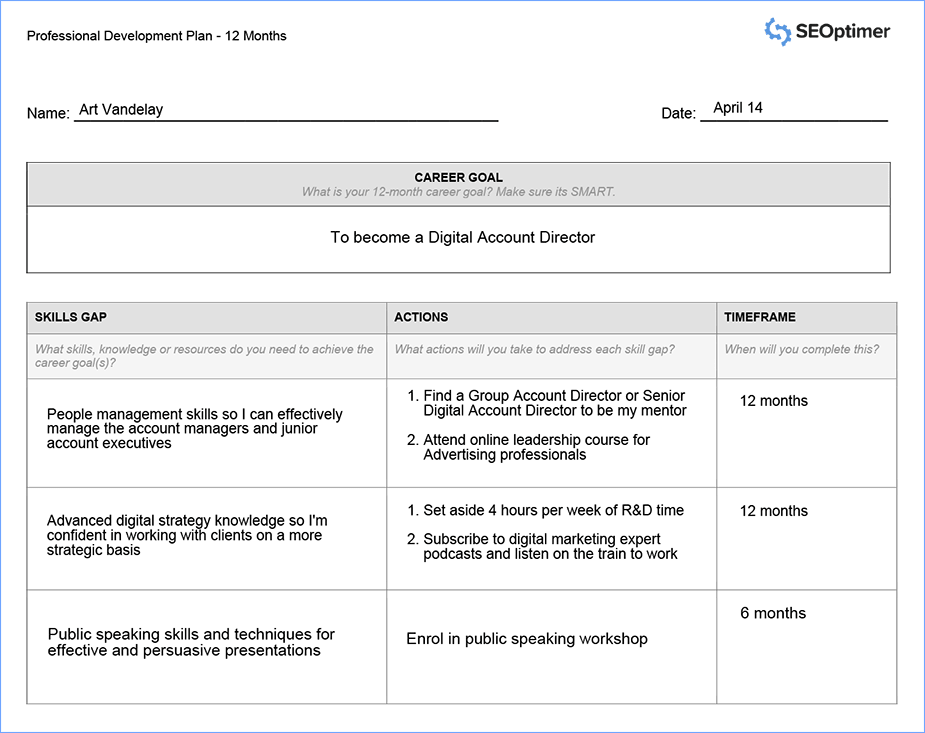
This one is slightly more detailed because it covers a specific career goal and lists particular skills gaps that need to be addressed and actions that can be performed within a timeframe.
When it comes to lessons you can learn from these plans and examples, one that matters is that the length of each development plan is at least 3 months.
Another learning is that you’ll have a host of documents regarding their skills and individual plans for each employee. If you have many employees, this documentation quickly piles up and requires lots of organization.
Of course, you could do this manually. But your time is precious.
Our tools allow you to manage your entire development framework on autopilot, making it easy to set and track employee development initiatives.
All of these examples have in common that they all look at development plans from an employee's perspective. While this is beneficial, it does miss out.
To design a harmonious employee development plan, you need to consider the needs of both - the employees' path to acquire new skills and the employer's journey to success.
However, we recommend at least a 50:50 mix between individual goals and the company perspective - with a tendency towards an employee's side.
Development plans are a great way to make colleagues feel valued, supported, and invested in.
But: Be careful about making false promises.
An overall career progression framework can take your L&D-strategy to a whole new level.
But: Be considerate and transparent about the impact people can expect.
Ask yourself: What exactly do people get out of fulfilling their plans? Is a raise feasible? Or is it merely for their own growth?
Just be sure you are aware of these benefits and call them out. And don't call anything out which you won't be able to deliver on.
➡️ Learn more about career progression models here.
Once you're running employee development for more than a bunch of people, things will quickly get messy:
With Zavvy, you can run your whole employee development framework in one central place - and on autopilot.
Awaken your static spreadsheets to life by
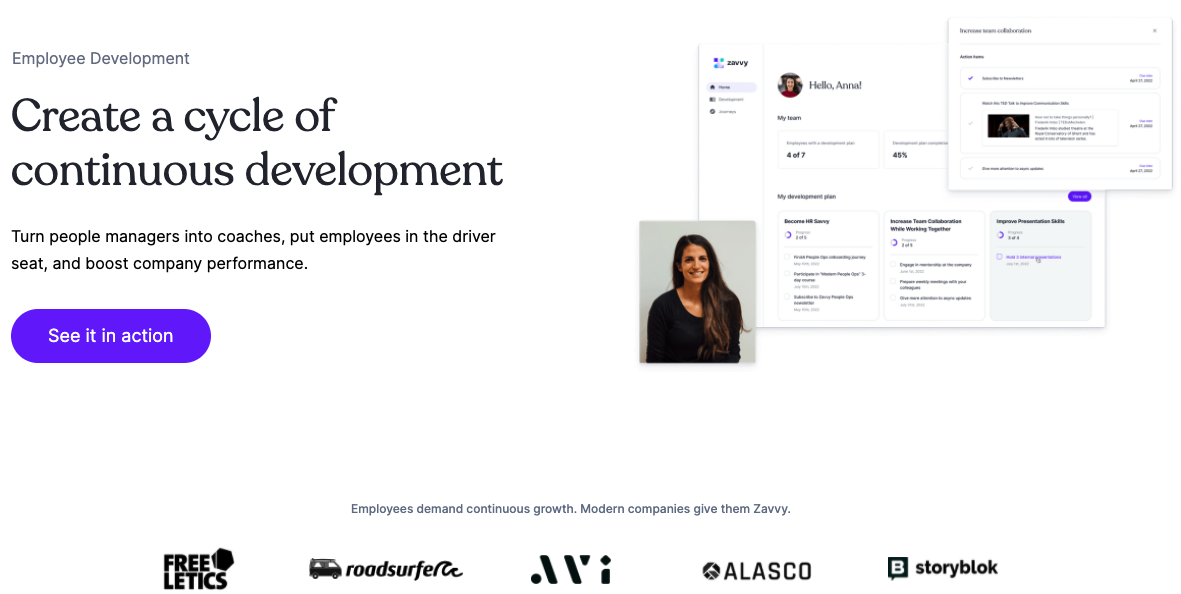
➡️ Learn how to run a cycle of continuous development - with Zavvy
For many companies, employee development plans are something they take for granted for too long. By the time they realise they need to help their employees, they already feel the negative effects of low employee satisfaction and high turnover.
Introducing an effective development plan benefits everyone - it makes your employees happier and it helps your company grow in the long run. If you’re on the fence, don’t be - start working on your employee development plans immediately! We’re here to help you every step of the way — from identifying room for improvement to tracking results, setting goals and achieving them with ease.
Upskill your team every week with the best contents and personalized recommendations.

Your people are your biggest asset.
And how you support their professional development will largely define your whole company's success.
The idea here is not to force employees to fulfill yet another list of seasonal tasks - but to help them unleash their potential. To enable them to perform at their best. Now and in the future.
Employee development plans are also a powerful tool to boost culture, motivation, and a sense of belonging.
While you help them become more efficient, you will reap the benefits through reduced turnover and higher employee retention rates.
However, employee development is a gigantic field by itself - and even experienced People Ops managers struggle with wrapping their heads around a streamlined strategy.
Well, we can confidently say that development plans are the single most central step towards creating a fully-fleshed growth framework for your people.
And we'll show you how to get started.
Get a demo!
We'll be happy to show you around and answer all your questions.
Trusted by innovative companies



We'll be happy to show you around, answer your questions, or arrange a free trial.
Erhalten Sie eine kostenlose Demo unserer Onboarding-Software.
Vertraut von



Your Training & Development Strategy - Solved in 1 Tool.
Trusted by innovative companies



We'll be happy to show you around, answer your questions, or arrange a free trial.
Learn how Zavvy helps you drive performance, development, and engagement.
Trusted by innovative companies



We'll be happy to show you around, answer your questions, or arrange a free trial.
We'll be happy to show you around and answer all your questions.
Trusted by innovative companies



We'll be happy to show you around, answer your questions, or arrange a free trial.
Gerne zeigen wir Ihnen ganz unverbindlich unsere Plattform im Detail.
Vertraut von modernen Unternehmen



Get a demo!
We'll be happy to show you around and answer all your questions.
Trusted by innovative companies



We'll be happy to show you around, answer your questions, or arrange a free trial.
Erhalten Sie eine kostenlose Demo unserer Software für Mitarbeiterenwicklung und Training.
Moderne Unternehmen
setzen auf Zavvy


